I haven’t found much reason to like the new Qianmen Dajie: it’s a commercialized travesty of its former self, with hordes of tourists, a sterile atmosphere, and myriad chain shops (noteworthy gems include H&M and “Cliocoddle,” with the Lacoste crocodile). No surprise that I hardly go there!
Then one day my grandmother told me about a Taiwan Street that opened during the Spring Festival. It sounded potentially bad, but we gave it a chance one smog-ridden afternoon out of curiosity.
At first sight, “Taiwan in Style” (台湾映像) looks much like the rest of Qianmen’s deserted side streets. In the heavy smog, I felt like I was wandering around a movie set, on which money had been lavished but not a drop of historical authenticity or aesthetics. In the main square there was a giant cement (!) tree. It was supposedly a replica of a “famous” tree from the Alishan mountains in Taiwan. Next to the tree was an old train car, for which no explanation was given.
All was looking bleak for Taiwan Street…until we found a food court in the basement, and G noticed that they were speaking Taiwanese and using Taiwanese phrases. Suddenly we had to join the crowds lining up at the many stalls, all cheerfully peddling a variety of Taiwan treats. And since then, we’ve been back twice more.
Chelun bing (车轮饼) or “cartwheel pies,” are very popular, with the longest lines. These hockey-puck shaped cakes have a eggy batter enclosing a filling – either sweet red bean, cream, or pickled, chopped turnip (菜脯 caipu). They’re cooked in an iron griddle, with first one layer of batter added, then the filling, then a final layer of batter. The result is something of a cross between an English muffin sandwich and a sponge cake.
The red bean variety was not too sweet and quite delicious, though unfortunately I did let them go cold for the sake of photography. But at RMB 12 for 3, they were too expensive to warrant trying another kind, though I’m curious as to how the pickled turnip might work with the sweet batter. I also prefer my chelun bing slightly smaller, so that there is a better ratio of crisp shell to the soft and spongy interior.
A bowl of 卤肉饭 (lu rou fan) is basic comfort food, simple and hearty. The braised pork was lightly sweet and soy saucey, making it perfect for mixing into the rice. I liked the fish ball that also came with it – I know they’re mostly starch and flavorings, not fish, but they still lure me as a guilty treat from my childhood. This one was surprisingly stuffed with a small pork meatball, and a little broth, like a fishy xiaolongbao. Still, fish ball or no, this was overpriced at RMB 16 for such a simple dish, especially when compared with Fanqian Fanhou’s smaller but tastier lurou fan for just RMB 6.
We also tried a “small sausage inside a large sausage” (大肠包小肠 dachang bao xiaochang). Or you might think of this as a “rice dog”: a grilled sausage is served with scallions and cucumbers inside a roll of sticky rice. The sticky rice is particularly nice at soaking up the meaty flavors of the sausage, though G missed the grilled garlic, basil, and other condiments that Taipei street vendors usually put into the sliced sausage.
My favorite by far was the baoxin fenyuan (包心粉圆), which are the best kind of tapioca pearls imaginable. These tapioca balls are larger than usual, about the size of a marble, and a deep ruby red in color. They’re red because they contain a single red bean in the center (the 心 or heart). Their texture are amazing: soft and mochi-like on the outside, with a chewy center, and finally the red bean in the heart. These guys are also the main reason why I’ve been lured back to Qianmen so many times since Spring Festival.
Made by a stall called Jing Yuan Ji (晶圆极), the baoxin fenyuan would be merely good and not astounding if they were not also served in some of the best grass jelly (烧仙草 shao xiancao) I have ever eaten. This obsidian-black jelly has a clean, lightly sweet flavor, with just a hint of herbal aroma. It’s cooling and slippery, and gently dissolves in your mouth (inferior grass jellies can be over-sweetened and too hard with artificial overtones). Quite popular in southern China, Hong Kong, and Taiwan, it’s made from a plant called mesona, from the mint family.
If grass jelly and red-bean-filled tapioca pearls are not good enough yet, there’s also a variety of toppings. The combination (综合 zonghe) has stewed red beans, mung beans, and peanuts, topped with condensed milk, while hongdou yuyuan (红豆芋圆) features red beans with soft cubes of stewed taro. In addition, Jing Yuan Ji can also serve the tapioca balls with black sesame soft tofu (heizhima douhua 黑芝麻豆花), which I am eager to try. A bowl costs between RMB 15 and 18, but unlike some of the other things, here, the baoxin fenyuan seemed entirely worth its price – you can’t find this anywhere else in Beijing, after all.
Taiwan Street (台湾魅力老街 Taiwan Meili Laojie or “Taiwan in Style” 台湾映像 Taiwan Yingxiang) [map] Located on Dajiang Hutong (大江胡同), which runs east off the Qianmen pedestrian street, about halfway down. Walking south from Qianmen, turn left (east) onto Dajiang Hutong and keep going until you see a square with a giant cement tree and a railway car. Just beyond that are stairs leading down into the basement food court. Dajiang Hutong can also be reached from Qianmen Donglu (前门东路), parallel and east of Qianmen Pedestrian Street. All stalls are named after what they sell, except for Jing Yuan Ji (晶圆极). The rice sausage is sold by one of the two chelun bing (车轮饼) makers. There’s also stinky tofu, ginger chicken, various kinds of noodles and soups, and – the most popular – oyster omelets. Less than half the stalls had opened while we were there, with more to come. You must buy a pre-paid card before you can buy anything. There are also stalls selling various Taiwan snack foods, teas, and condiments.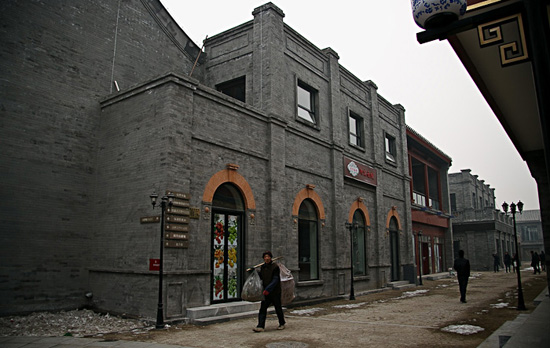
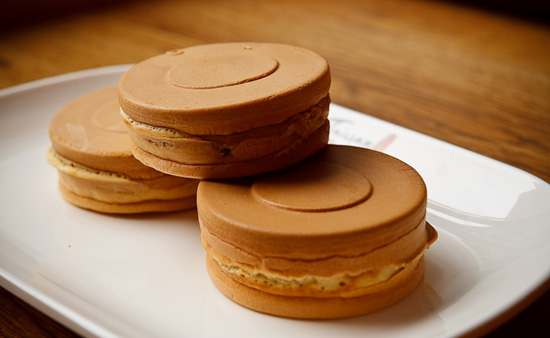
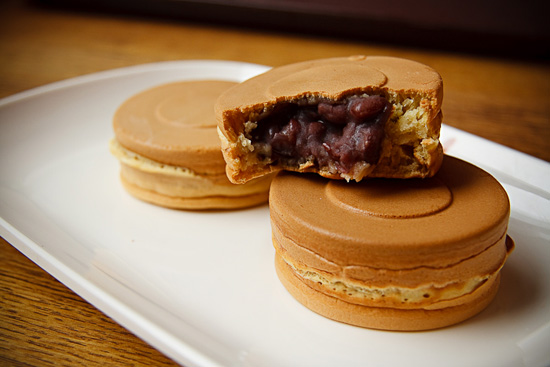
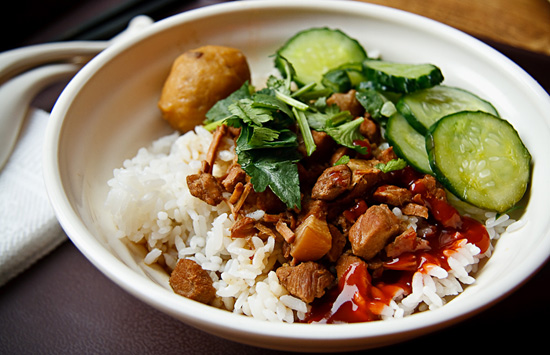
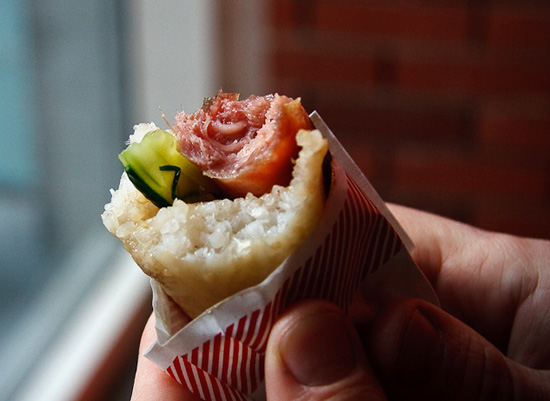
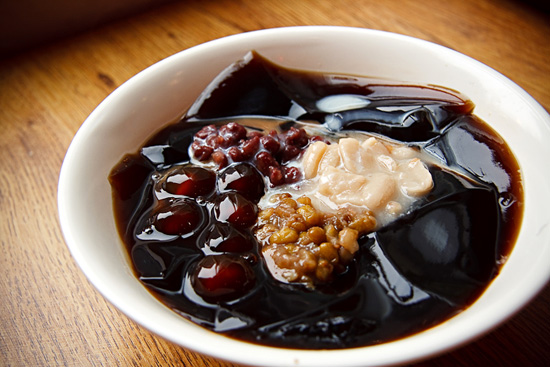
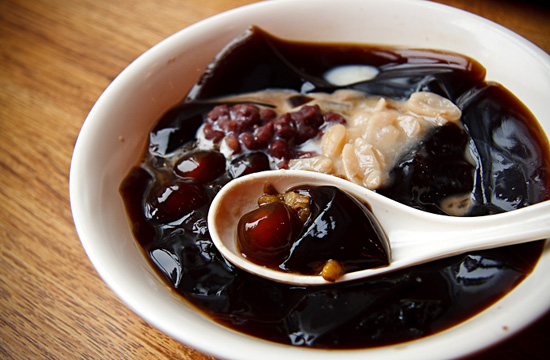



































OMG love love those red bean cakes, they have those in Singapore and I ate them often, I didn’t know it was Taiwanese though!